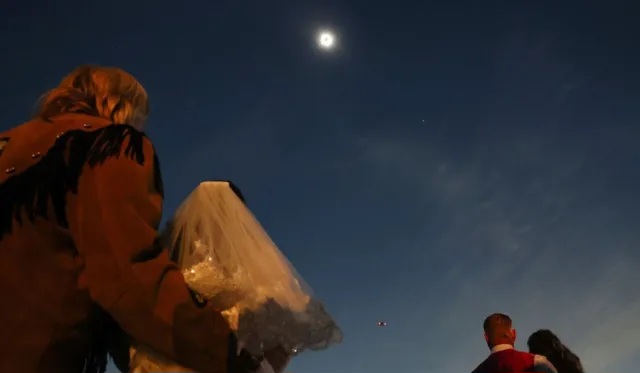By Emmanuel Banafemi
In a rare celestial display, North America recently bore witness to a breathtaking solar eclipse that captivated skywatchers across the continent. This awe-inspiring event not only mesmerized individuals in Canada, the United States, and Mexico but also served as a unifying experience, transcending borders and bringing people together in shared wonder.
From the rugged coastlines of Canada to the bustling cities of the United States and the tranquil landscapes of Mexico, people eagerly awaited the rare alignment of the sun, moon, and Earth. Families, friends, and astronomy enthusiasts alike gathered in parks, public squares, and observatories, armed with specialized glasses and telescopes to safely observe the event. In the days leading up to the eclipse, educational workshops and public outreach efforts were organized to promote safe viewing practices and enhance public understanding of the astronomical phenomenon.
As the moment of totality approached, excitement filled the air. In Canada, cities such as Vancouver, Toronto, and Montreal became hubs of activity as crowds gathered to witness the moon’s gradual obscuration of the sun. Across the United States, from the Pacific Northwest to the East Coast, communities came together in parks, schools, and public viewing events, eagerly awaiting the celestial show. In Mexico, residents from bustling urban centres to serene coastal towns turned their gaze skyward, eager to catch a glimpse of the eclipse’s partial phases.
Despite challenges posed by overcast conditions in some areas, dedicated skywatchers persevered, finding moments of clarity to witness the celestial event. As the moon cast its shadow across the continent, exclamations of awe and wonder filled the air, uniting people from diverse backgrounds in a shared appreciation for the beauty and mystery of the cosmos.
ALSO READ: Explaining the difference between total, annular, solar, lunar eclipses
Canada: Marveling under the eclipse
In cities like Vancouver, Toronto, and Montreal, Canadians of all ages and backgrounds marvelled at the celestial ballet unfolding before their eyes. Families, friends, and astronomy enthusiasts alike gathered in parks, public squares, and observatories, equipped with specialized glasses and telescopes to witness the sun’s gradual obscuration by the moon. As the sky darkened and the temperature dropped, expressions of wonder and excitement filled the air, creating a moment of shared astonishment.
United States: A cosmic gathering
Across the United States, from the rugged landscapes of the Pacific Northwest to the iconic skylines of cities like Seattle, Denver, and New York City, people gathered to experience the celestial phenomenon. In parks, schools, and public viewing events, excitement soared as the moon cast its shadow across the nation. As strangers became friends, united by their shared fascination with the wonders of the cosmos, exclamations of awe and amazement echoed through the crowd.
Mexico: Embracing celestial beauty
In Mexico City, Guadalajara, Cancun, and beyond, residents turned their gaze skyward to witness the eclipse’s partial phases. Despite challenges posed by overcast conditions in some areas, many managed to witness the eclipse, marvelling at the sight of the moon’s shadow dancing across the sun’s surface. Against the backdrop of ancient pyramids, colonial architecture, and pristine beaches, the eclipse served as a powerful reminder of the beauty and mystery of the universe.
A shared moment of wonder
As the solar eclipse unfolded across North America, it became more than just a celestial event—it became a shared moment of wonder and unity. Across borders and cultures, people came together to witness the beauty of the universe, forging connections that transcended language and nationality. And as the moon slowly relinquished its hold on the sun, the skies returned to their usual splendour, leaving behind memories of a celestial event that united people across the continent in a shared moment of celestial wonder and appreciation.
Thousands of people witnessed a celestial spectacle that plunged parts of North America into momentary darkness.
 Fernando Llano/AP
Fernando Llano/AP Jeff Overs/BBC
Jeff Overs/BBC Hector Vivas/Getty Image
Hector Vivas/Getty Image Henry Romero/Reuters
Henry Romero/Reuters Henry Romero/Reuters
Henry Romero/Reuters Henry Romero/Reuters
Henry Romero/Reuters Julio Cortez/AP
Julio Cortez/AP Julio Cortez/AP
Julio Cortez/AP Leah Millis/Reuters
Leah Millis/Reuters Chet Strange/Bloomberg via Getty Images
Chet Strange/Bloomberg via Getty Images JOSH EDELSON/Getty Images
JOSH EDELSON/Getty Images Mario Tama/Getty Images
Mario Tama/Getty Images Shannon Stapleton/Reuters
Shannon Stapleton/Reuters ANGELA WEISS/Getty images
ANGELA WEISS/Getty images ANGELA WEISS/Getty Images
ANGELA WEISS/Getty Images






Be First to Comment